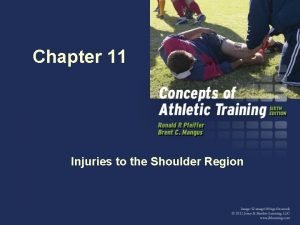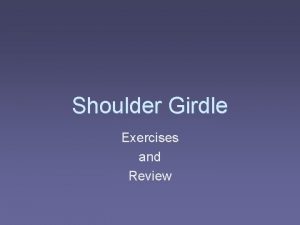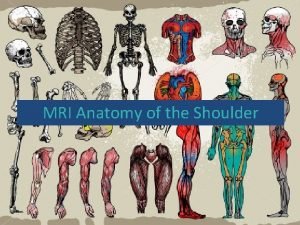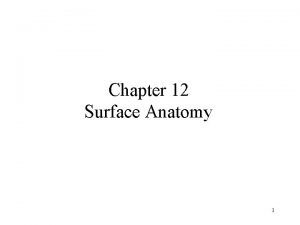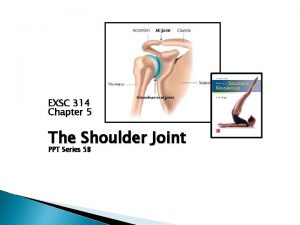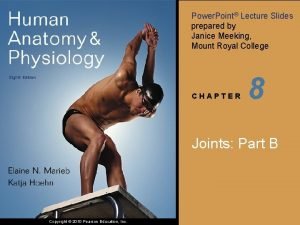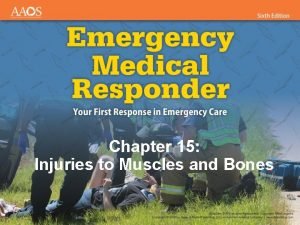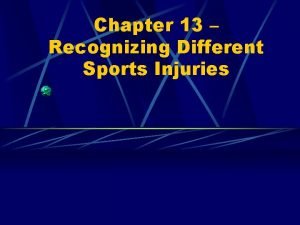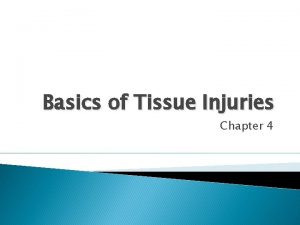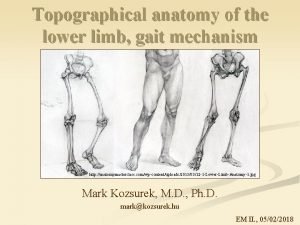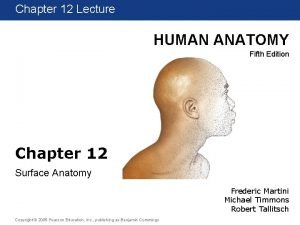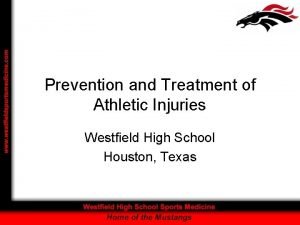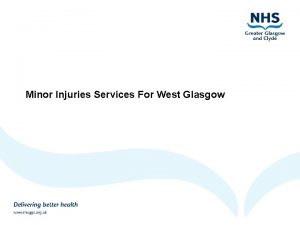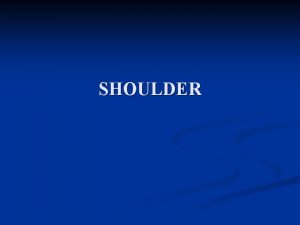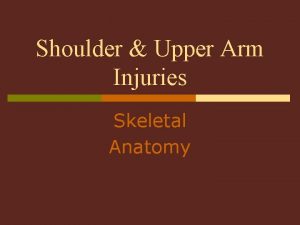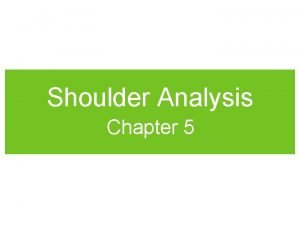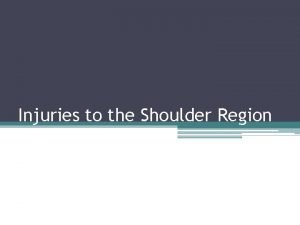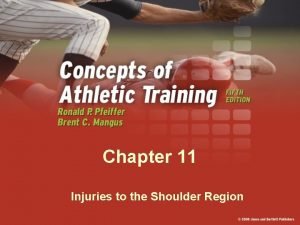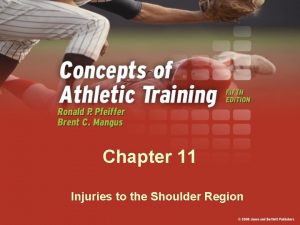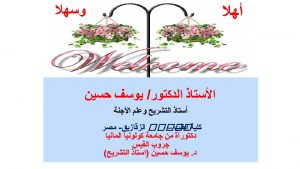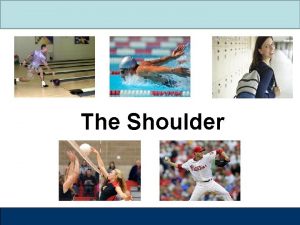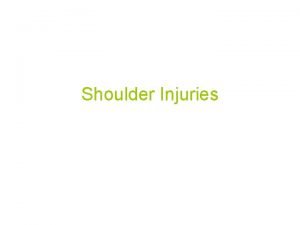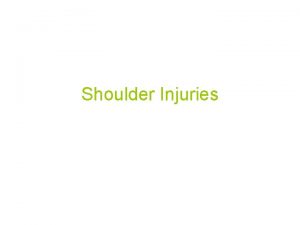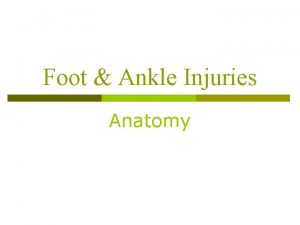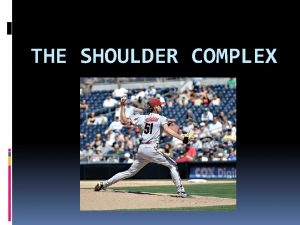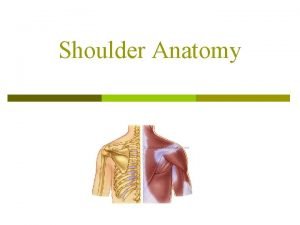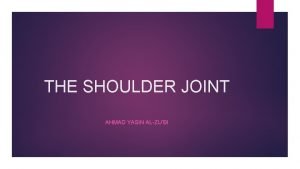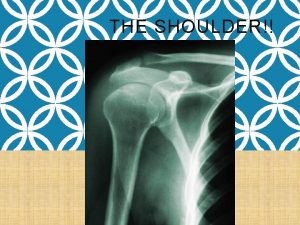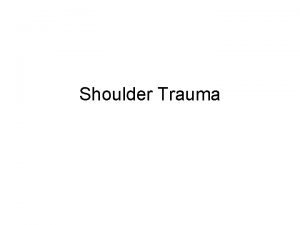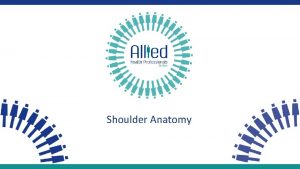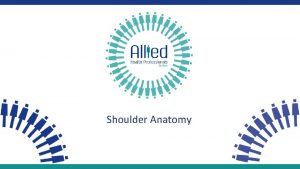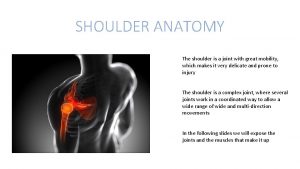Chapter 11 Injuries to the Shoulder Region Anatomy
































- Slides: 32

Chapter 11 Injuries to the Shoulder Region

Anatomy Review Bones: • Clavicle and Scapula • Shoulder girdle humerus. • Humerus Shoulder joints: • Glenohumeral • Acromioclavicular • Sternoclavicular

http: //www. shouldersurgeon. com/ shoulder_anatomy/index. htm

Anatomy Review • Joints are held together with ligaments and joint capsules that provide stability and allow for limited movement. • Acromioclavicular joint (AC) • Coracoclavicular joint (CC) • Glenohumeral joint (GH) • AC joint is just under the skin and is vulnerable to injury. • GH joint is commonly dislocated.

Anatomy Review Anterior musculature Posterior musculature

Muscles of the Rotator Cuff • • • SITS Supraspinatus, Infraspinatus, Teres Minor, Subscapularis

Shoulder Injuries • Injuries to the shoulder region are common in many sports. • Falls in any sport but especially cycling and skating can result in fractures of the clavicle. • AC and SC joint injuries are common in wrestling. • Glenohumeral dislocations are common in contact sports. • Throwing and swinging sports can result in overuse injuries to the rotator cuff. • Injuries can be either chronic or acute.

Fractured Clavicle • Fractures of this bone are the most common fracture in the shoulder region. • This injury usually results from falls or direct blows. • The adolescent form of this injury is known as a “greenstick” fracture. • All clavicular fractures are potentially dangerous to neural and vascular structures and should be treated by physician.

http: //youtu. be/RSqz 0 Mps 6 a. M

Fractured Clavicle Signs and symptoms include: • Swelling, Deformity and Discoloration. • Athlete will hold the arm to relieve pressure. First Aid • Treat for shock. • Apply sling & swathe bandage. • Apply sterile dressings on any wounds. Courtesy of Kevin G. Shea, MD, Intermountain Orthopaedics, Boise, Idaho

Fractured Scapula • Uncommon injury that is normally the result of a direct blow. • Signs and symptoms are less clear than those for a fractured clavicle. Symptoms include: • History of severe blow. • Considerable pain and functional loss to shoulder girdle. • An athlete with such a history and symptoms should be referred to a medical doctor.

Acromioclavicular (AC) Joint Injuries • AC joint is located on the lateral superior aspect of the shoulder, just under the skin. • Injuries involve AC ligaments & CC ligaments.

AC Joint Injuries • Typical mechanism is downward blow to the lateral shoulder or fall on an outstretched arm. • Severity of injury is graded on the amount of damage to ligaments. • 1 st degree – no significant ligament damage. Stretching of AC ligament. • 2 nd degree – partial tearing of ligaments. • 3 rd degree – complete rupture AC and CC ligaments.

AC Joint Injuries (cont. ) Signs and Symptoms • Mild swelling with point tenderness. • Any movement of the shoulder region will be painful. • In third-degree sprain, a snap or pop may have been sensed along with a visible deformity. First Aid • Treat for shock and Apply RICE. • Apply sling & swathe bandage. • Refer athlete to a physician. Courtesy of Ron Pfeiffer

Sternoclavicular (SC) Joint Injuries • The sternoclavicular joint is formed by the union of the proximal end of the clavicle and the manubrium of the sternum. • SC joint is supported by the several ligaments. • Injuries are rare compared to AC or GH joints. • Mechanism is external blow to the shoulder resulting in a dislocation of proximal clavicle; most commonly, with the clavicle moving anteriorly and superiorly.

Sternoclavicular Joint Injuries Signs and symptoms include: • Gross deformity of SC joint (second- and thirddegree sprains). • Swelling & painful movement. • Snapping or tearing sensations related to the injury. • Athlete holds arm on affected side close to the body. First Aid • Treat for shock. • Apply ice and compression. • Sling & swathe bandage.

Glenohumeral (GH) Joint Injuries • GH joint consists of humeral head and the glenoid fossa of scapula. • Extremely mobile but inherently unstable joint. • Major soft tissue structures include capsular ligament and the coracohumeral ligament. • Typical mechanism of injury is having the arm abducted and externally rotated, stressing the anterior glenohumeral ligament. • Most common type of location is an anterior dislocation that may be a subluxation or complete dislocation.

Glenohumeral Joint Injuries Signs and symptoms include: • Shoulder joint deformity and down-sloping shoulder contour. • Abnormally long arm on affected side. • Humeral head palpable within axilla. • Athlete supports arm on affected side & resists efforts to move GH joint. In cases involving subluxation: • GH joint may appear normal. • Movement will be very painful. • Joint may be point tender.

Glenohumeral Joint Injuries First Aid • Treat for shock. • Application of ice and compression by placing rolled towel into the axilla. • Apply sling & swathe bandage. • Refer to a physician immediately. • GH joint injuries tend to be chronic and recur (85 -90% likely). Surgical treatment may be necessary.

Shoulder Review • http: //www. youtube. com/watch? feature=player_d etailpage&v=D 3 GVKje. Y 1 FM

Muscle Strains • Any muscle of the shoulder can suffer a strain. • Most common injury is rotator cuff strain. • Errors in the execution of a throw or swing can contribute to overuse injury. • Rotator cuff muscles contribute to GH joint stability plus abduction & rotation.

Rotator Cuff Strains Mechanisms • Concentric force development followed by eccentric loading of RC muscles during deceleration and followthrough cause most injuries. Signs and symptoms include • Pain within the shoulder, especially during follow through phase of throwing motion. • Difficulty bringing arm up and back during cocking phase of throw. Pain and stiffness in shoulder region 12 to 24 hours after throwing or swinging. • Point tenderness around region of the humeral head that seems to be deep in deltoid muscle.

Rotator Cuff Strains First Aid • First aid is NOT practical due to chronic nature of condition. • RICE. • Rehabilitation exercises and flexibility improvements. • Medical referral.

GH Joint-Related “Impingement” Syndrome • Occurs when a bursa or tendon is squeezed between moving structures. • In cases affecting the GH joint, the tendon of the supraspinatus muscle is commonly impinged.

Impingement Syndrome • Any condition that decreases the size of the subacromial space or causes poor alignment of the humerus with the glenoid fossa may result in impingement syndrome. • May involve weak scapular muscles or rotator cuff group. • May be linked with overuse. • Athletes in sports that emphasize overhead arm movements have a high risk of this injury.

Impingement Syndrome Signs and symptoms • Pain with abduction & external rotation. • Strength loss. • Pain when arm is abducted beyond 80° to 90°. • Nocturnal pain. • Pain felt deep within the shoulder. First Aid • First aid is NOT practical due to chronic nature of condition • Rest, anti-inflammatory drugs. • Progressive strength training. • In extreme cases, surgery.

Biceps Tendon Injuries • Long head of the tendon can be compressed within the subacromial space (impingement syndrome). • Long head of the tendon may develop tendonitis. • When the tendon enlarges as a result of inflammation, it becomes less stable in the groove. • Violent force may subluxate the long head of the tendon from the bicipital groove – often called a SLAP lesion.

Biceps Tendon Injuries Signs and symptoms • Painful abduction of the shoulder joint. • Painful abduction and external rotation of shoulder. • Pain in shoulder joint when the athlete supinates the forearm against resistance. • Resisted flexion and supination yields a snapping and/or popping sensation.

Biceps Tendon Injuries First Aid • This is an “overuse” type of injury; there are no first aid procedures for the chronic condition. • Traumatic tendon subluxations should be treated with immediate application of ice and compression. • Long-term care includes rest, antiinflammatories, and gradually progressive rehabilitation exercises. • If symptoms persist, surgery may be necessary.

Contusions of the Shoulder Region • In sports, external blows are common to this region. • The GH joint is well protected by muscles while the AC & SC joints are exposed. • Contusions to this region can result in a “shoulder pointer. ” • Intense pain over the bony process, much like a “hip pointer”.

Contusions of the Shoulder Region Signs and symptoms include: • Recent history of blow to shoulder. • Decreased ROM. • Muscle spasm. • Discoloration and swelling, especially over bony areas such as the AC & SC joints. First Aid • Immediate application of ice and compression. • Sling & swathe bandage. • If significant swelling persists for more than 72 hours, refer athlete to physician.

Jeopardy Review • jeopardylabs. com/play/shoulder 15.
 Chapter 11 injuries to the shoulder region
Chapter 11 injuries to the shoulder region Shoulder anatomy bodybuilding
Shoulder anatomy bodybuilding Aber view mri positioning
Aber view mri positioning Pelvis surface anatomy
Pelvis surface anatomy Shoulder complex ppt
Shoulder complex ppt Shoulder anatomy
Shoulder anatomy Uniaxial
Uniaxial Chapter 28 head and spine injuries
Chapter 28 head and spine injuries Chapter 21 caring for head and spine injuries
Chapter 21 caring for head and spine injuries Chapter 17 1 providing first aid
Chapter 17 1 providing first aid Chapter 15 injuries to muscles and bones
Chapter 15 injuries to muscles and bones Chapter 14:2 preventing accidents and injuries
Chapter 14:2 preventing accidents and injuries Chapter 14 bleeding shock and soft tissue injuries
Chapter 14 bleeding shock and soft tissue injuries Chapter 13:2 preventing accidents and injuries
Chapter 13:2 preventing accidents and injuries Chapter 11 assessment and evaluation of sports injuries
Chapter 11 assessment and evaluation of sports injuries Chapter 12 lesson 4 fitness safety and avoiding injuries
Chapter 12 lesson 4 fitness safety and avoiding injuries Chapter 4 preventing injuries through fitness
Chapter 4 preventing injuries through fitness Chapter 13 worksheet recognizing different sports injuries
Chapter 13 worksheet recognizing different sports injuries Chapter 4 basics of tissue injuries
Chapter 4 basics of tissue injuries Site:slidetodoc.com
Site:slidetodoc.com Ece
Ece Tigh
Tigh Parafalcine region anatomy
Parafalcine region anatomy Anatomy region
Anatomy region Riolan muscle
Riolan muscle Makalu gau
Makalu gau Unit 15:6 providing first aid for burns
Unit 15:6 providing first aid for burns What is the physical condition of peeta and katniss?
What is the physical condition of peeta and katniss? What are sentinel injuries
What are sentinel injuries Westfield sports injuries
Westfield sports injuries Victoria hospital glasgow minor injuries
Victoria hospital glasgow minor injuries Hammock carry definition
Hammock carry definition Kristen wilson injuries
Kristen wilson injuries
